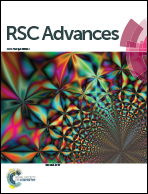Origin of large field-induced strain of azobenzene/polyurethane blend dielectric elastomers
Abstract
Herein a diaphragm type dielectric elastomer actuator by blending azobenzene dyes into a polyurethane matrix (Azo/PU) is described. The effects of azobenzene content on the dielectric, mechanical, and electromechanical properties of the Azo/PU blends are discussed. The resultant blends with azobenzene content ranging from 1 to 8 wt% were characterized. The dielectric permittivity of PU increased from 8.0 to 11.1 (increasing of 38.5%) at 1 wt% azo content and reached a maximum of 35.6 (increasing of 343%) at 4 wt% azo content. By blending with a small content of azo the dielectric breakdown strength reached 57 kV mm−1, which is 86% higher than that of the neat PU. The 30 μm thick diaphragm of Azo/PU blend with 1 wt% azo content exhibited the highest actuated displacement at the center around 700 μm. Meanwhile the neat PU gave a displacement of 25 μm. That is a 26-fold increase in actuation is obtained by blending only 1 wt% azo dyes into the PU matrix. Infrared spectroscopy was used to characterize the structure of the Azo/PU blends. The particular chemical structure the Azo/PU blend containing 1 wt% of azo dyes is proposed to be responsible for the improvement in electromechanical actuation.


 Please wait while we load your content...
Please wait while we load your content...